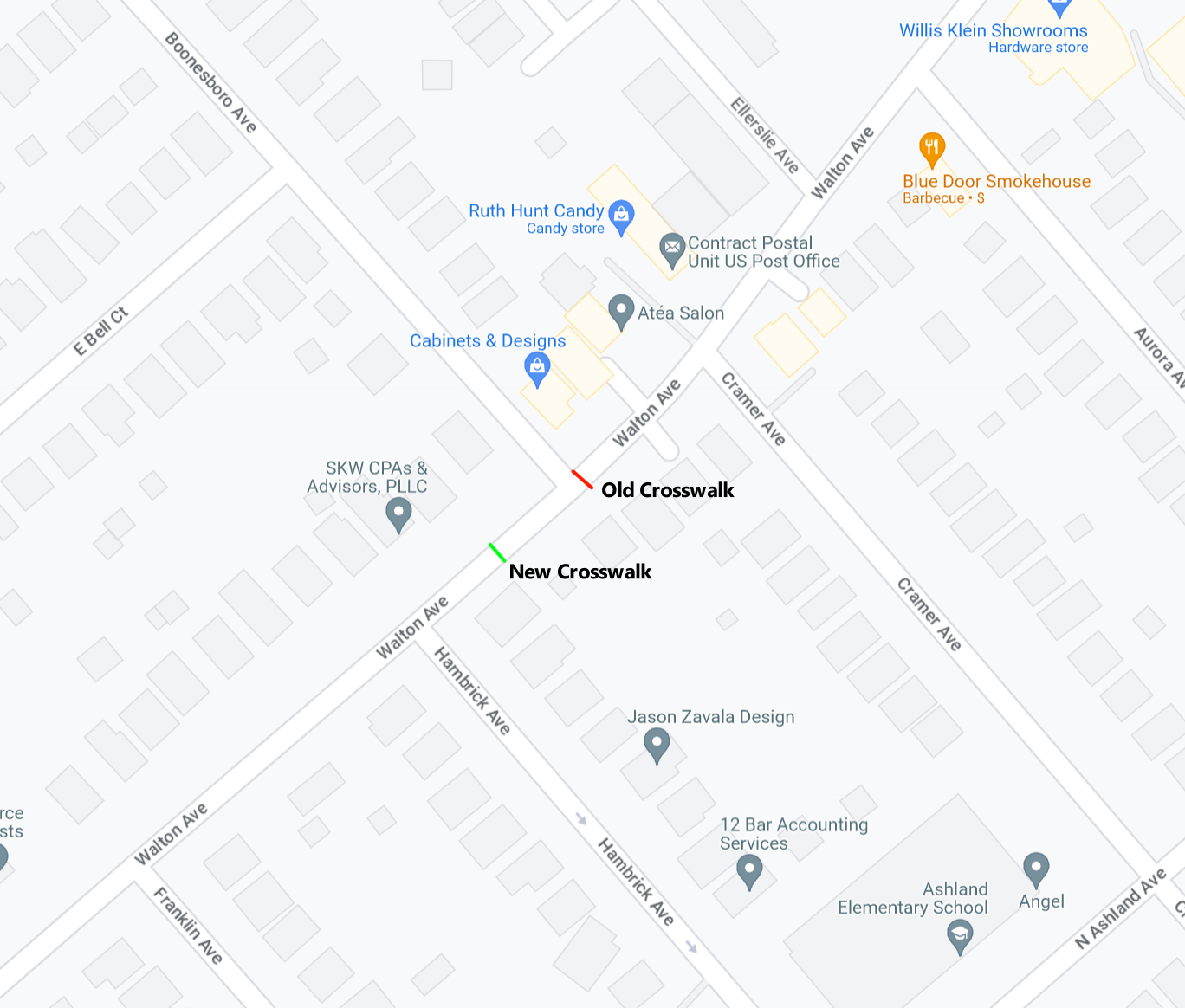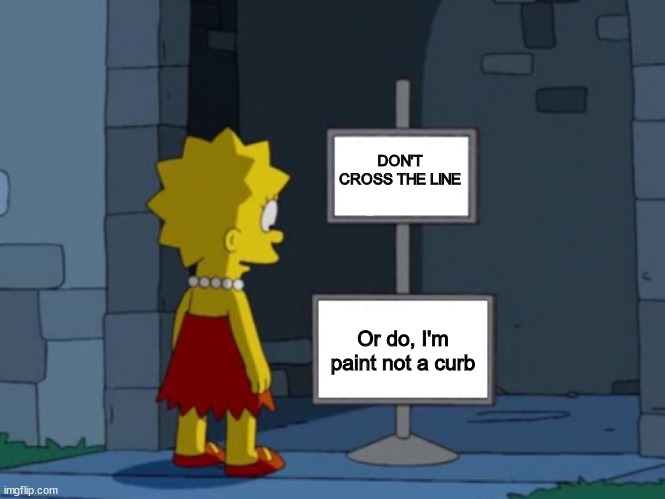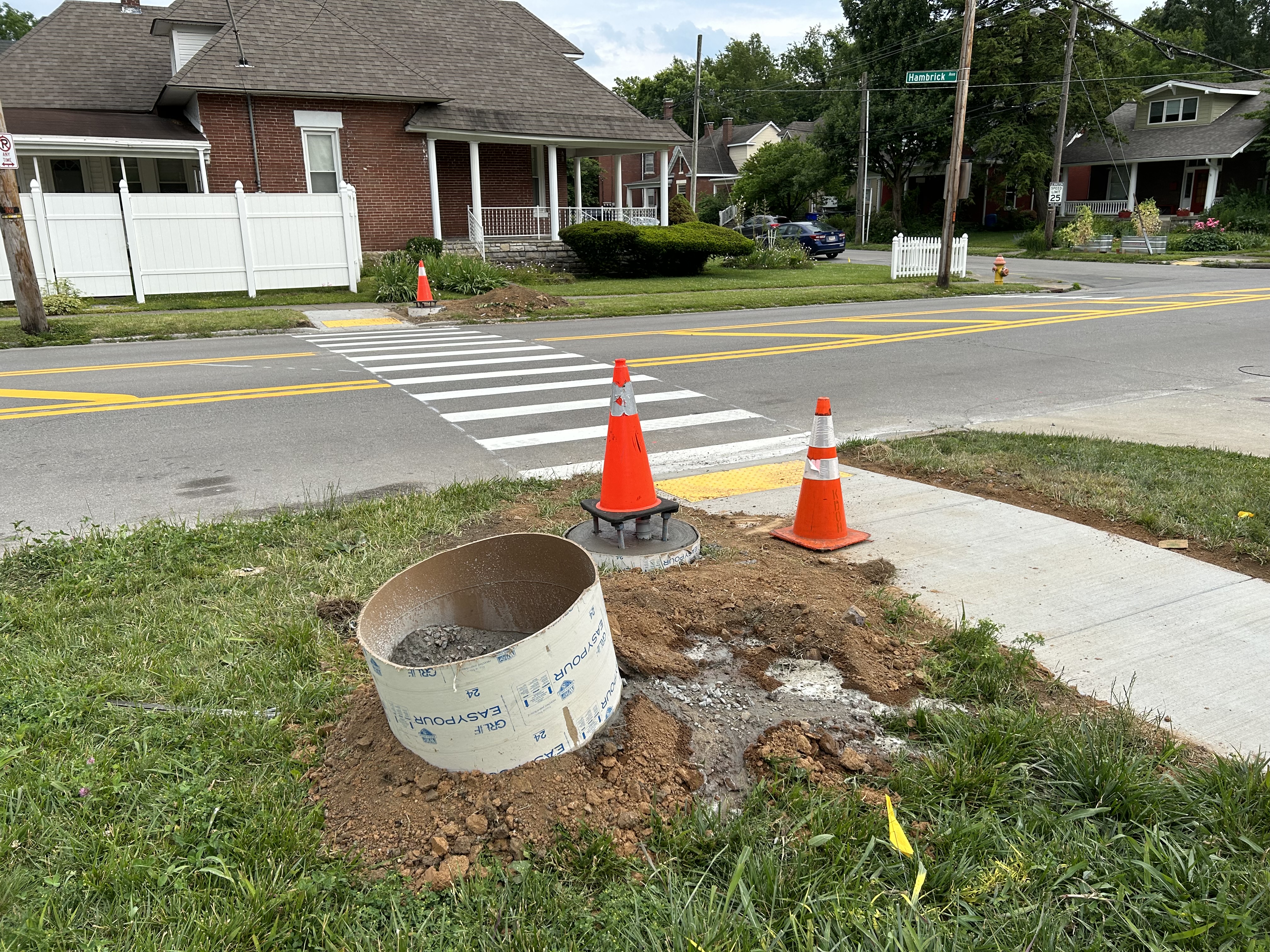So the crosswalk on Walton Avenue, the crosswalk which has been a chip on my shoulder ever since I moved back 6 years ago, has finally been updated. And the result is simply disappointing. Warning; a heavy amount of snark ahead.
For a reminder of my issue with this crosswalk, see this post from back in 2019, but it can be summed up as this; the street was too wide which caused drivers to speed and rarely yield to pedestrians trying to cross. Rather than address the width of the street, over the years the city tried a couple of milquetoast band aid interventions to try to make it better. All of them were ineffective. My personal favorite that you can still see in old Google StreetView images is a “Yield to Pedestrians” bollard sign in the middle of the crossing. I was told it was removed because it kept getting hit by cars…
So what is the city’s new solution that will totally be effective and not a total waste of money? They moved it. About 100 feet down the street towards Hambrick.

They also changed how the street is striped. Now there is a large painted median that runs from Cramer to Hambrick.

There also are some concrete footings, with what look to be break away bolts, on either side of the crossing. These are probably for signs, maybe even the (useless) flashing lights that were installed at the last crossing.
What’s wrong with it
So why am I so disappointed in this? First, it’s just more paint. The lanes were narrowed at the old crossing with only paint and they’ve done the same exact thing here. Paint doesn’t protect, but it also has little impact on speeds when the actual street is still massively wide. Drivers will still drift over the lines to maintain their speed. In fact, I saw one car do it as I was taking these pictures. It might have a chance to be effective if the median had some plastic bollard or was raised, but as it stands now I’m fully expecting to see the paint worn away in the middle where cars keep drifting over the line. Maybe I’ll post another update in 6-12 months.

But it’s not just the city’s inability to address the actual root cause of the issue by physically narrowing the lanes, it’s also where they chose to move it. For context, Walton separates the Bell Court neighborhood, with Bell House and it’s park, from the “Warehouse Block” - a commercial strip on National Avenue, Ashland Elementary school, and the Mentelle and Kenwick neighborhoods. This means that anyone walking from Bell Court to dinner or drinks on National, or someone from Kenwick wanting to enjoy the park, will now have to walk 200 feet out of their way. The new location is worse for every trip except maybe walking from Bell Court to Ashland Elementary.
This is especially frustrating when, down the opposite direction, there is the intersection with Cramer Avenue. Cramer Avenue is the main thoroughfare through Mentelle and Kenwick. Unless they are going to National, I’d bet that most pedestrian trips went to or from Cramer. It connects to the school, Wilson’s, and Kenwick Table. It also ends at Ruth Hunt Candy, a local chocolate/candy store, but also a USPS drop location. Even when the crossing was at Boonesboro, you had people regularly crossing at Cramer to mail letters, myself included. This new location does nothing but make that more likely.

If the location is so bad, why was it chosen? I was told the new location was chosen for three reasons:
- It allows for an increase in visibility for vehicles coming from Winchester Road.
- Vehicles will have more time to reduce their speed before the crosswalk.
- The location allows for median lines to be painted which allows for pedestrians to cross one lane at a time.
I take issue with these because they ignore the fundamental problem of drivers going too fast. The curve on Walton is incredibly minor and wouldn’t be an issue to a driver going the speed limit. Long sight lines for visibility and long stopping distances aren’t needed if the cars are going slower. Pedestrians don’t need a refuge if cars actually yield to them. Speeding is a major factor in whether or not a driver will yield. A recent study showed that while drivers will yield 75% of the time when driving 20mph, that rate plummets to 12.5% when speeds hit 30mph. This is incredibly simple; if you want drivers to yield to pedestrians, you need to slow them down. And if you want to slow them down, physically narrowing the street is most effective.
At first glance, this doesn’t seem like a very big deal. 100 feet is not very far for a detour, even when you double it because you have to double back. But longer distances encourage pedestrians to cross outside crosswalks. That’s one of the reasons NACTO suggests 300 feet between crossings and to take into account the surroundings. This line from their crosswalk guidelines sums it up perfectly:
In general, if it takes a person more than 3 minutes to walk to a crosswalk, wait to cross the street, and then resume his or her journey, he or she may decide to cross along a more direct, but unsafe or unprotected, route.
Sacrificing pedestrian safety and convenience to preserve car convenience and dangerous behavior isn’t a fair compromise. You shouldn’t have to walk out of your way just because the city doesn’t want to slow cars down to the speed limit. This is the direct result of our city’s policy of no traffic calming on collectors - what Walton is categorized as. There is no consideration for the posted speed, if the street is improperly designed, or where pedestrians are trying to go. This prevents many forms of traffic calming. Plastic bollards would be more effective and probably cheaper, but they aren’t even considered because that would be a physical change. Instead we get paint, signs, maybe some flashing lights, and a worse location. Until that policy changes, pedestrians will continue to be treated as second class citizens and have to deal with subpar facilities.
